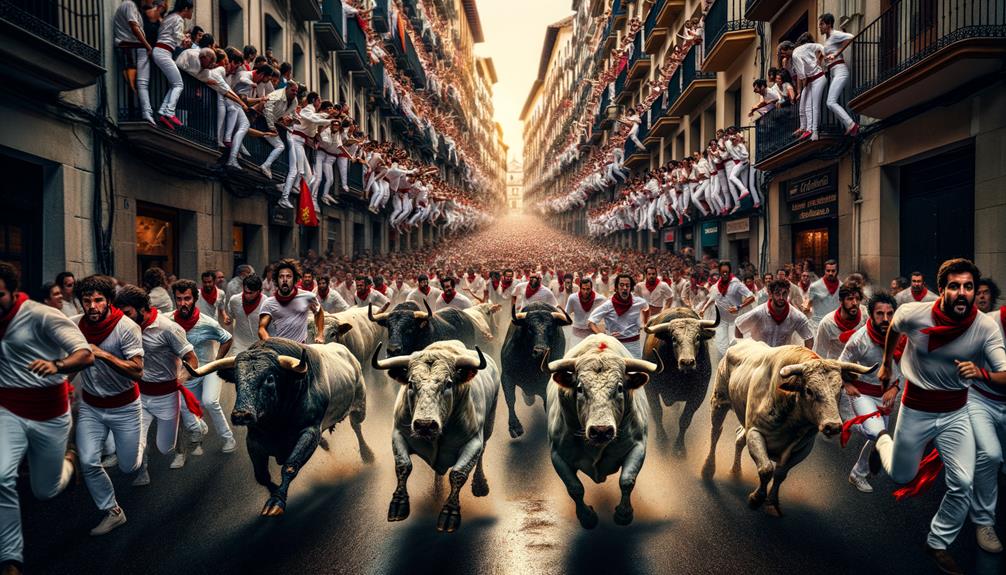Over a million people descend upon Pamplona every July to experience the thrill of the Running of the Bulls. As I wandered through the narrow, cobblestone streets, I felt the electric atmosphere – a mix of anticipation and tradition. The iconic white outfits with red sashes worn by participants created a striking visual contrast, painting the town in a sea of opposing hues. The history and cultural significance of this event are palpable, but it's not without its criticisms. From the locals' deep-seated passion to the critics' concerns about animal welfare, there's more to this storied tradition than meets the eye.
History and Origins
Have you ever wondered how the thrilling tradition of running with the bulls in Pamplona began? It all started over 400 years ago with a group of butchers who had to herd bulls through the narrow streets to the bullring. As part of their daily routine, young apprentice butchers sought a bit of excitement by running ahead of the bulls. This daring act quickly caught the attention of the locals, and soon enough, the general public joined in.
The tradition gradually evolved into a significant cultural event, especially during the San Fermín festival. What began as a practical task transformed into a vibrant spectacle that captures the spirit of Pamplona. The running of the bulls now holds deep historical origins and cultural symbolism, attracting thrill-seekers from around the globe.
San Fermín isn't just a festival; it's a celebration of life, heritage, and an adrenaline rush like no other. This blend of history, culture, and sheer excitement is what makes the running of the bulls a must-see event. It's a testament to how traditions can morph over centuries, becoming something extraordinary and unforgettable.
Event Details
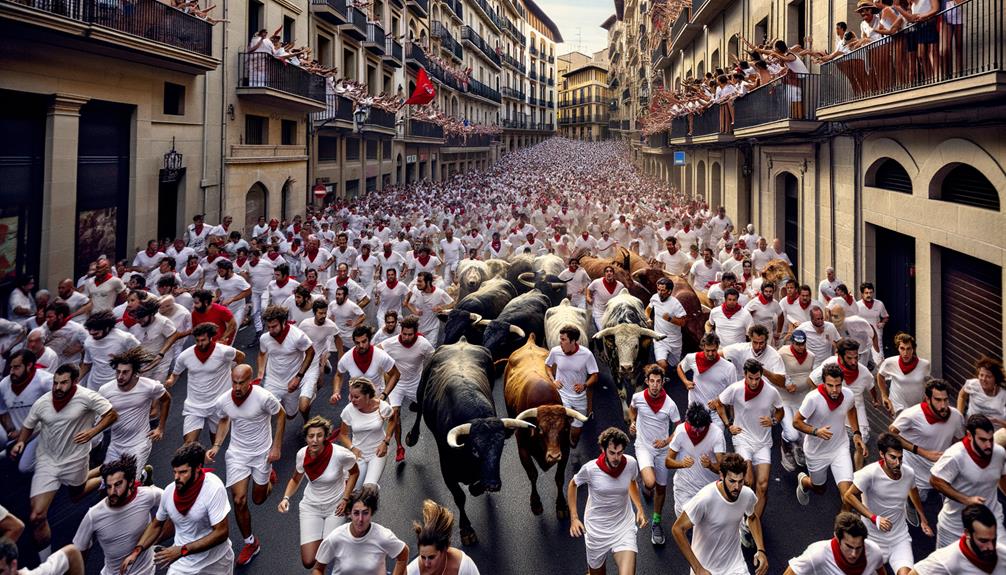
Standing in the heart of Pamplona's old city, I couldn't help but notice the tightly packed 875-meter course winding through the narrow streets. The energy was electric as participants, dressed in traditional white with red waistbands, prepared for the 8 a.m. start signaled by the rockets. What struck me was how the run, ending in the bullring, was meticulously organized to balance tradition and safety amidst the chaos.
Course Route Overview
The Running of the Bulls in Pamplona begins on Santo Domingo street, a chaotic 875-meter dash through narrow streets that culminates inside the iconic bullring. As you stand at the starting point, the air is electric with anticipation – in mere moments, you'll be sprinting alongside powerful bulls, guided by experienced bell-oxen. The early morning sun casts long shadows on the cobblestones, a jarring contrast to the mayhem that's about to erupt.
As you take off, the route winds past the Ayuntamiento square, where the roar of the crowd surges your adrenaline. Navigating these tight, winding streets is a daunting task – the bulls are swift, and the path is packed with participants, each vying for their own thrill. Although the course is fenced off for safety, the sense of danger is palpable, adding to the allure of this iconic event.
Daily Schedule Highlights
Each morning at 8 a.m., Pamplona's streets come alive as thousands of runners clad in white and red prepare for the heart-pumping thrill of the Running of the Bulls. The air is charged with anticipation as the event, part of the San Fermín festival, gets underway. This daily spectacle is a delicate balance of tradition and adrenaline, where participants, known as 'mozos,' join six bulls and six steers on a 875-meter dash through the city's narrow streets.
The run begins with the firing of the first rocket, signaling the release of the bulls. As the herd charges forward at speeds of up to 24 km/h, the runners keep pace, navigating the twists and turns of Pamplona's historic lanes. The second rocket confirms the bulls are on the move, while the third signals their entry into the bullring, marking the event's end.
Though the run itself lasts only 15 to 20 seconds for most participants, its impact resonates throughout the day. Locals and tourists alike gather in bars to watch live coverage and replays, reliving the morning's excitement. The Running of the Bulls is a vivid display of Pamplona's vibrant spirit and enduring traditions.
Safety Guidelines
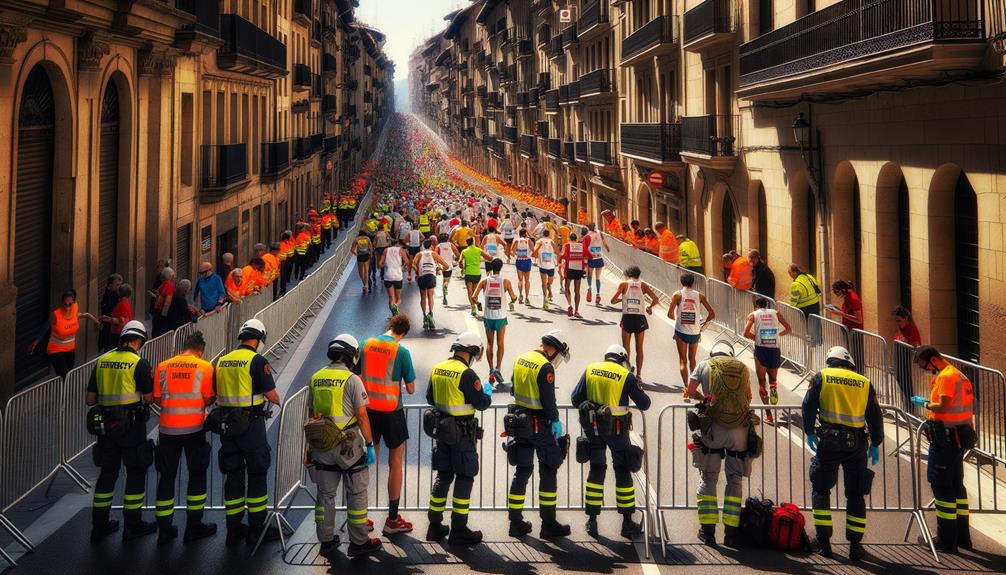
As I geared up to run with the bulls in Pamplona, I was keenly aware of the strict safety guidelines in place to protect us participants. Clad in the traditional white attire with a red waistband, I took note of the 875-meter course carefully fenced off to ensure a controlled environment. With medical teams on standby, I felt a mix of excitement and reassurance, knowing that every precaution was taken to mitigate the risks involved.
Essential Safety Tips
Exploring the thrill of Pamplona's Running of the Bulls demands a sharp awareness of essential safety tips to ensure both tradition and safety are respected. As a Bull Runner, staying vigilant and alert is crucial. Keep an eye out for rocket signals that indicate the bulls' release and their progress through the city's narrow streets – the front of the pack can be particularly chaotic.
Wearing traditional white attire, including the red Pañuelo (bandana) and Faja, not only makes you part of the vibrant scene but also increases your visibility. Before you run with the bulls, avoid drinking alcohol – you need to keep your judgment and reflexes sharp.
Familiarizing yourself with the course is vital. Know every twist, turn, and potential escape route. The bulls move quickly and unpredictably, and having an exit strategy can mean the difference between an exhilarating run and a dangerous encounter.
Injury Prevention Measures
To fully experience the thrill of the Running of the Bulls, it's crucial to prioritize injury prevention measures. As I made my way through Pamplona's narrow streets, I noticed the city's strong commitment to safety guidelines. Authorities have set up robust safety barriers, which are vital for both runners and spectators. These barriers keep the bulls on course and provide designated escape routes for anyone needing a quick exit.
Medical personnel are strategically stationed along the route, ready to provide immediate treatment if needed. Their presence is reassuring, but it's essential to stay vigilant and follow the rules. Participants are strongly advised to avoid alcohol before the run, as it can severely impair judgment and reflexes, increasing the risk of accidents.
The rush of the running experience is undeniable, but it comes with risks, ranging from minor bruises to serious goring incidents. Pamplona's strict regulations aim to minimize these risks. Staying alert and respecting the guidelines isn't just about personal safety; it's about honoring a tradition that balances excitement with a deep respect for life and limb.
Emergency Medical Support
While observing the meticulous injury prevention measures, I couldn't help but notice the well-coordinated emergency medical support that stands ready during the Running of the Bulls. The dedicated medical teams are strategically positioned along the route, fully prepared to provide immediate medical treatment for injuries such as goring and trampling. It's reassuring to see this, especially given the large number of participants – around 2,000 per run – who flood the streets, increasing the likelihood of incidents.
The city has taken several measures to ensure everyone's safety:
Medical teams are stationed at specific points along the route, allowing them to respond quickly in case of an emergency. The streets are cleaned with water to prevent the cobblestones from becoming too slippery, reducing the risk of falls. The route is also lined with double barriers, which limit the bulls' path and provide spectators with safer viewing areas. Additionally, specific gateways are designated for medical personnel to access the route quickly if needed.
Foreign participants should be aware that medical treatment may incur costs if not covered by insurance. However, the presence of such diligent emergency medical support is a testament to the city's commitment to safety. This aspect is crucial in ensuring this thrilling, high-adrenaline event remains as secure as possible.
Participation Rules
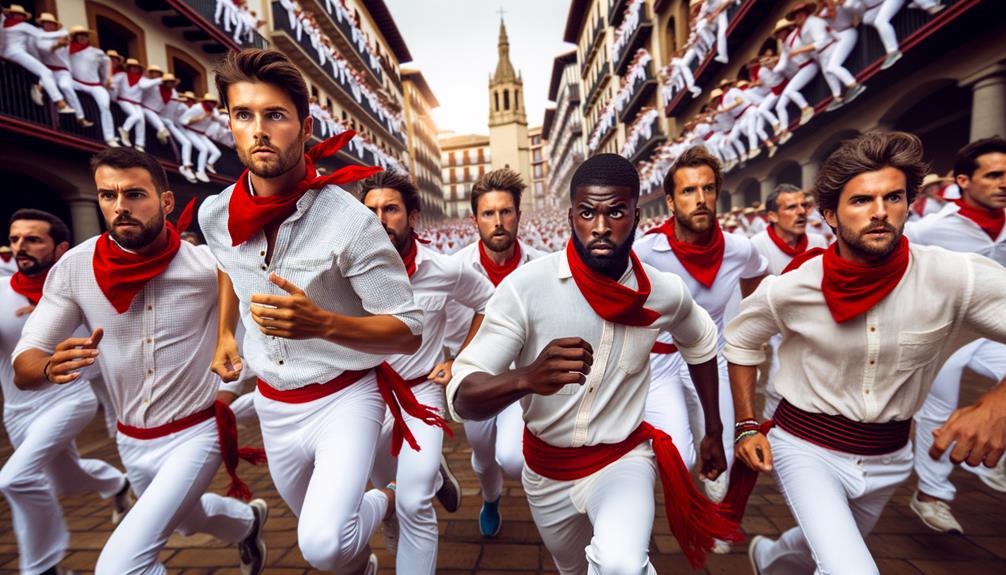
To take part in the Pamplona Running of the Bulls, you need to be at least 18 years old and willing to follow strict safety rules set by local police. On the day of the event, participants gather early, their energy palpable, each one aware that the bull run demands respect and adherence to rules for the safety of both runners and bulls.
There's no official sign-up process, which adds to the sense of freedom. You simply show up, but you must be mindful of the local police, who closely monitor the event to ensure everyone follows the rules. These rules include not touching the bulls, staying sober, and dressing appropriately – typically, in the traditional white outfit with a red scarf. The 875-meter course, which starts at Santo Domingo street and ends in the bullring, is fenced off for safety.
As you observe the camaraderie among participants, it's clear that everyone shares an unspoken bond, driven by the thrill and danger of the event. The atmosphere is electric, and while the freedom to run is exhilarating, the rules exist to ensure this centuries-old tradition continues safely for generations to come.
Ticketing and Accommodations
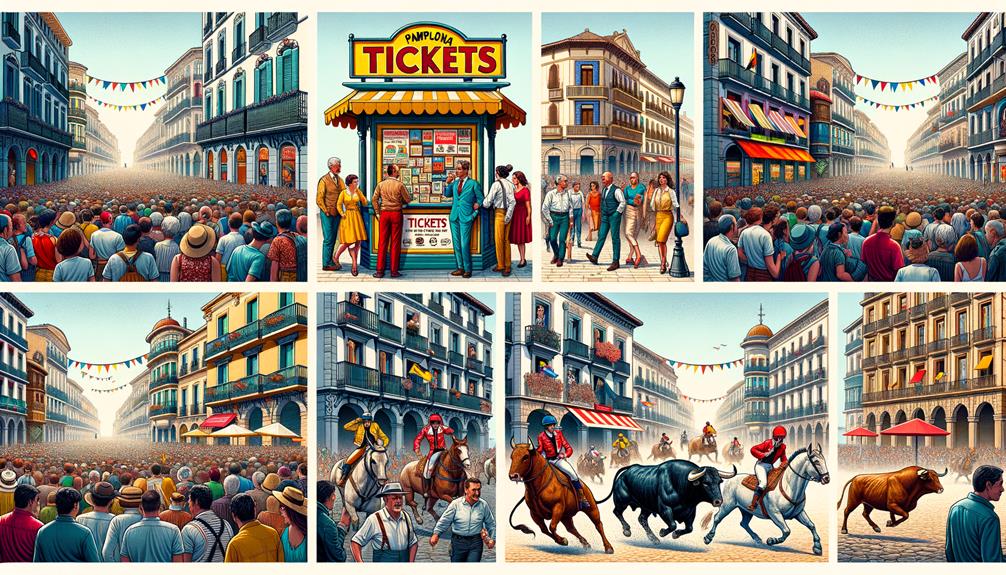
Finding ticketing and accommodations for the Pamplona Running of the Bulls can be an exhilarating experience in itself. Last-minute premium balcony spots and exclusive hotel deals add to the thrill. Securing a Bull Run Balcony spot provides an unmatched view of the action, particularly during the Opening and Closing Ceremonies of San Fermin. These spots are limited, so snagging one is a rush.
Booking a Pamplona hotel can be an adventure in itself. The Castillo de Gorraiz offers luxurious comfort, while a Bordeaux Wine Country VIP experience brings elegance to your stay. Both options provide comfort and proximity to the festivities, allowing you to fully immerse yourself.
Bullfight Tickets, especially for events featuring stars like Roca Rey in July 2012, are highly sought after. Witnessing a bullfight at Plaza de Toros, with its vibrant atmosphere, brings the essence of Spanish culture to life.
To secure your spot:
Book early, especially for premium balcony spots and top hotels.
Seek assistance from services that help with ticket and accommodation bookings.
Be flexible, as last-minute deals can offer great value.
Stay central, choosing accommodations close to the action for convenience.
Tour and Package Options

Exploring tour and package options for the Pamplona Running of the Bulls offers a wide range of choices to enhance your San Fermín experience. From the start, you'll find packages catering to every interest and budget, allowing you to customize your visit with the perfect mix of excitement and relaxation.
Booking with a reputable tour operator often provides access to experienced guides who know the ins and outs of the festival. They can navigate the over 400 events scheduled during San Fermín, ensuring you don't miss out. Reading trustworthy guest reviews can give you valuable insights into the quality of various tour experiences, helping you make informed decisions.
When considering booking options, look at the group sizes and the expertise of the guides. Smaller groups often mean more personalized attention, which can greatly improve your experience. Additionally, booking with a tour operator can provide not only cost savings but also a hassle-free experience, allowing you to fully immerse yourself in the vibrant culture and thrilling events of the Running of the Bulls.
Cultural Significance

Amid the fervor and excitement of the Pamplona Running of the Bulls, the cultural significance of this centuries-old tradition reveals itself in every corner of the city. As I walk through Pamplona during the San Fermín festival, I'm struck by the deep-rooted traditions that have shaped this vibrant celebration.
The Encierro heritage, born from butchers moving bulls into town, has evolved into a competitive event where brave souls run in front of the bulls. This practice embodies courage and camaraderie, showcasing the spirit of the participants.
Participants don white outfits with red accessories, paying homage to San Fermín, the patron saint of Navarra, whose feast day is at the heart of the festival. The religious processions reflect the city's devotion to its heritage.
Ernest Hemingway's novel brought international attention to Pamplona, transforming the local event into a global phenomenon. His influence is still felt, as many tourists follow in his footsteps through the city.
The bullfights are a central feature, blending spectacle with tradition. Though controversial, these events are steeped in history and hold a significant place in the festival.
Exploring Pamplona during this time provides a profound insight into the cultural fabric of this unique celebration.
Controversies and Opposition
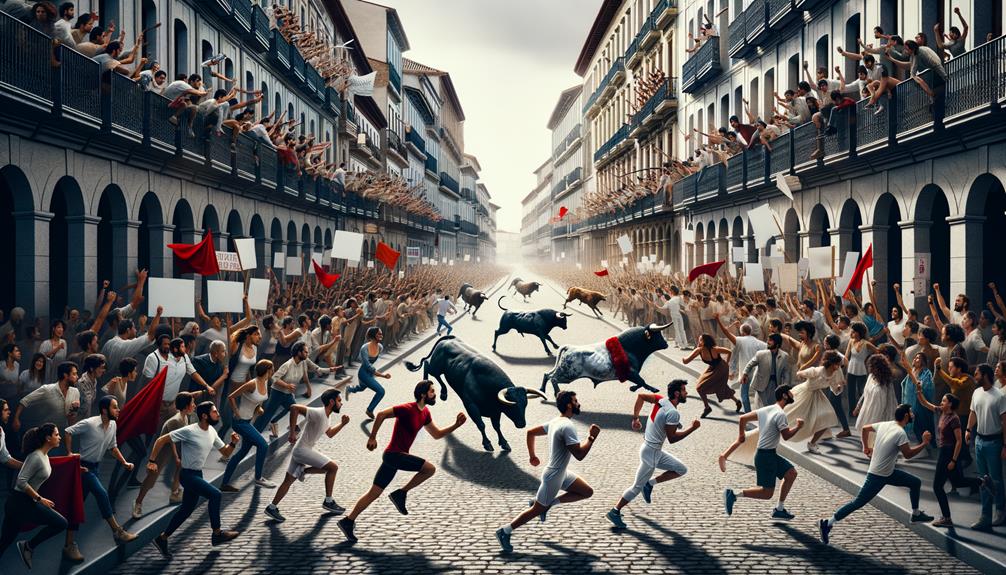
The allure of the Pamplona Running of the Bulls is overshadowed by growing controversies and fervent opposition. As I wandered through the vibrant streets, I couldn't ignore the rising voices against the event. Critics argue that the bulls endure mental stress and potential harm during the run. The controversial practices, such as roping the bulls and attaching flares to their horns, add fuel to the fire of animal rights concerns.
Animal rights activists are increasingly vocal, calling for a ban on what they perceive as cruelty. They believe these majestic creatures deserve respect and humane treatment. Meanwhile, safety risks for participants, like goring and trampling, can't be overlooked either. The thrill-seekers who dash alongside the bulls often face severe injuries, adding another layer to the opposition.
Despite this, the event still garners robust support from local communities and has even inspired similar events around the globe. The tension between tradition and modern ethics is palpable. Here's a breakdown of the contrasting perspectives:
| Aspect | Supporters' View | Opponents' View |
|---|---|---|
| Animal Treatment | Cultural heritage | Animal cruelty |
| Safety for Humans | Personal responsibility | High injury risk |
| Cultural Significance | Deep-rooted tradition | Outdated practice |
| Global Influence | Celebrated worldwide | Promotes harmful behavior |
In this clash of values, the future of the Pamplona Running of the Bulls remains uncertain.

